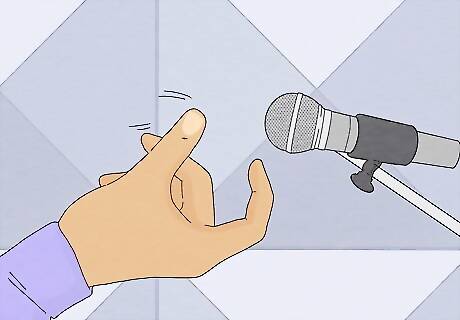
views
Getting Comfortable Holding a Microphone

Practice with objects similar to a microphone. Even if you don’t always have access to a microphone during your solo practice time, you will still get the feel for singing with an object in your hand. You can use something like a hairbrush or water bottle to simulate the feeling of holding the microphone while you are singing. Microphones are fairly heavy, so use an object with some weight. For example, if you are using a water bottle for practice, use a full water bottle rather than an empty one.

Hold the microphone at a 45-degree angle. The rounded head of the microphone will be next to your mouth. Grasp the microphone firmly with all the fingers of the hand of your choice. If you want, you can support the microphone with both hands or switch between hands. Your grip should be firm but not overly tight. Don’t grasp any part of the head of the microphone, as this can muffle the sound. Your hand should be around the middle of the microphone.

Keep your elbow in towards your body. This is the elbow of the arm holding the microphone. Keeping it close helps to anchor your microphone and keep the sound steady. However, don’t hold it so tightly close to you that it restricts your airflow or rib cage expansion while singing.

Use a microphone stand. If you aren’t comfortable holding a microphone, you can ask to use a microphone stand. This keeps your arms free and can help ease your nerves. In certain settings, like a recording studio, your microphone will most likely always be on a stand, so you won’t need to worry about holding it.
Singing into Your Microphone

Position the microphone close to your mouth. Vocal microphones are designed for close use. However, you don’t want to touch the microphone with your mouth. Optimally, your mouth should be about one to four inches from the center, or axis, of the head of the microphone. If you are using a stand, make sure the stand is raised so that the head of the microphone is at the level of your mouth when you are standing up straight. The top of the microphone's head should be directly across from your lower lip. You don't want to have to either raise or lower your chin to sing into the microphone.

Keep your head steady. Because you want your mouth to be pointed towards the center of the microphone, your tone can change if you move your head around too much. When you move your head during a performance, make sure that you move your microphone along with your head. Alternately, try to keep your head held steady above the microphone.

Maintain your posture. Your posture is an integral part of your sound when you are singing. You want to make sure that your microphone placement allows you to keep your good posture in place. Your back and neck should be comfortably straight. You don’t want to hunch over your microphone. You also don’t want to have to lift up your chin to sing into your microphone.

Test your microphone. Whether you are recording or performing, you want to test your microphone before you begin and become familiar with it. Know how to turn your microphone on. It may seem silly, but you want to make sure you are comfortable with the basics of the specific microphone you are using. As you sound check, don’t just say a few words. Sing a portion of your songs, trying to test a range of notes and levels. You want the sound tech to adjust the microphone to your specific voice and tone, rather than you trying to adjust to the microphone. Make sure you can hear yourself, whether you’re listening in the speakers or have a headset. If you can’t hear what you are singing, ask the sound tech to adjust your microphone or headset. Make sure the sound is clear. Listen for any unwanted feedback. This can be an indication the levels need to be adjusted.

Don’t over or under compensate in volume. You want to sing at your natural level, neither too softly or too loudly. Resist the temptation to adjust your distance from the microphone when you sing at different volumes or pitches. The microphone should be adjusted to you. You want to sing at a normal volume. Don’t feel like you have to hold back on big crescendos just because you’re singing into a microphone. When you’re going through sound check, make sure you are singing at the level you’ll be singing during your performance.


















Comments
0 comment